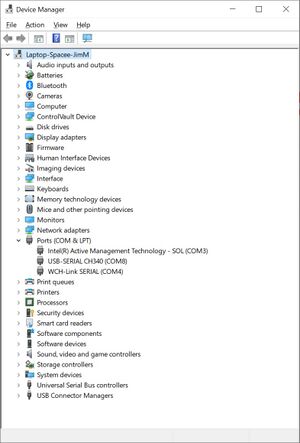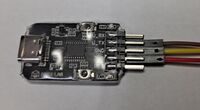Getting Started with CH32V003: Difference between revisions
Jump to navigation
Jump to search
No edit summary |
No edit summary |
||
| Line 63: | Line 63: | ||
https://www.wch.cn/downloads/file/409.html | https://www.wch.cn/downloads/file/409.html | ||
I2C Example using AT24C256 EEPROM - Link: | |||
https:// | https://pallavaggarwal.in/2023/10/05/ch32v003-programming-i2c-eeprom/ | ||
==Current Project Status== | ==Current Project Status== | ||
Revision as of 14:43, 5 August 2024
After watching David Jones's YouTube "EEVblog 1524 - The 10 CENT RISC V Processor! CH32V003",
https://www.youtube.com/watch?v=L9Wrv7nW-S8&ab_channel=EEVblog
I had to learn more about this chip.
Where to get a CH32V003 development board
I ordered this board: along with the programmer and cable for $7.50: https://www.aliexpress.us/item/3256805035436953.html Repository for board with documentation and example code: https://github.com/wuxx/nanoCH32V003 The github repo's README.md file: https://github.com/wuxx/nanoCH32V003#readme Schematic: https://github.com/wuxx/nanoCH32V003/blob/master/hardware/nanoCH32V003.pdf I created a RISC-V folder under Documents like so: C:\Users\Jim\Documents\RISC-V While inside the RISC-V folder, I cloned the repository like so: git clone https://github.com/wuxx/nanoCH32V003.git Inside the "doc" folder is the zipfile, CH32V003EVT.ZIP, with "EVT" folder inside. Unzip the EVT folder into "doc", so you have the example code available. This zip file was provided by WCH, providing examples for the CH32V003, not specifically for the nanoCH32V003 board. CH32V003 website: http://www.wch-ic.com/products/CH32V003.html The device on the development board is: CH32V003F4U6, with 18 GPIOs in a QFN20 package
MounRiver Studio IDE
Download the latest version of MounRiver Studio IDE from the official website: http://www.mounriver.com/ and install it.
More info concerning the board
According to the schematic, the LED is connected to PD6 If using the GPIO example project, need to change source code to use PD6, not PD0.
WCH-LinkE v1.0
After plugging in the WCH-Link USB-Serial programmer, the device should display in Window Device Manager


The programmer comes with a 4-conductor cable, wire colors: brown (1), red (2), orange (3), yellow (4) I connected the LinkE programmer to the nanoCH32V003 target board as follows: Target LinkE GND - brown - GND DIO - yellow - SWDIO 3V3 - red - 3V3
WCH-Link Utility
This software tool connects with the WCH-LinkE programmer, and allows the user to read, write, examine program data written to the RISC-V device. https://www.wch.cn/downloads/WCH-LinkUtility_ZIP.html
Notes & References
As noted in the YouTube EEVblog, the TSSOP20 package for this part appears to be pin compatible with the STM8S003F3, https://www.st.com/resource/en/datasheet/stm8s003f3.pdf, at 1/3rd the price. The UFQFPN20 package doesn't appear to be pin compatible. Other websites for the CH32V003: https://www.cnx-software.com/2023/02/22/ch32v003-risc-v-mcu-gets-1-5-development-board-open-source-gcc-toolchain-and-flasher-utility/ https://hackaday.com/2023/03/02/a-ch32v003-toolchain-if-you-can-get-one-to-try-it-on/ https://github.com/AlexanderMandera/arduino-wch32v003 https://www.tindie.com/products/adz1122/ch32v003-risc-v-mcu-development-board/ Example code provided by the processor manufacturer: http://www.wch.cn/downloads/CH32V003EVT_ZIP.html https://www.wch.cn/downloads/file/409.html I2C Example using AT24C256 EEPROM - Link: https://pallavaggarwal.in/2023/10/05/ch32v003-programming-i2c-eeprom/
Current Project Status
Today, 4/15/23, I started to work with this nanoCH32V003 development board. I soldered on the header pins. I then connected GND, DIO, and 3V3 signals from the 3-wire programmer interface to the WCH-LinkE board. When I attempted to use the WCH-Link Utility with the WCH-LinkE, the tool indicated I needed to update the firmware. After a few attempts, this process completed successfully. Now, using WCH-Link Utility, I'm able to read the flash program from the target and save it to a file. (Good first step) I built the sample GPIO project, "GPIO_Toggle", downloaded the resulting GPIO_Toggle.bin file to the target board. NOTHING! No Blinky! I'm able to reprogram the board using the saved flash data. - That works! LED: 500ms high, 500ms low. With a scope in hand, I see PD0 is toggling nicely. Seems the example software was developed for a different board or something. Changed the software to use PD6, that connects to the on-board LED. The LED is now blinking as expected! The GPIO example, GPIO_Toggle project, also enables serial debug output on D6 (UTX). After attaching an FTDI USB-Serial board to GND and D6, I'm receiving serial debug on my Tera Term terminal. SystemClk:48000000 GPIO Toggle TEST